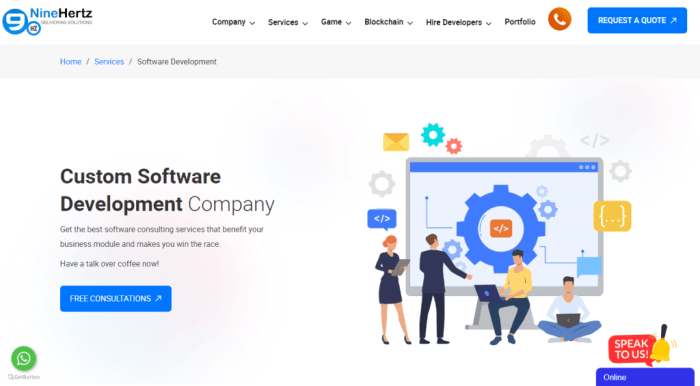Nearshore software development partner. – In today’s rapidly evolving technological landscape, businesses of all sizes are increasingly reliant on robust and efficient software solutions. Finding the right development partner is crucial for success, and the nearshore model is emerging as a compelling alternative to onshore and offshore options. This comprehensive guide delves into the intricacies of nearshore software development partnerships, exploring their benefits, challenges, and key considerations for businesses seeking to leverage this approach.
Understanding Nearshore Software Development
Nearshore software development refers to outsourcing software development projects to a country geographically closer to your business. Unlike offshore outsourcing, which often involves significant time zone differences and cultural disparities, nearshore partners are typically located in neighboring countries or regions with similar time zones and cultural understanding. This proximity fosters enhanced communication, collaboration, and project management.
Key Advantages of Nearshore Partnerships
- Reduced Time Zone Differences: Easier communication and collaboration, leading to faster project turnaround times and quicker problem resolution.
- Cultural Proximity: Shared cultural values and business practices often lead to smoother project execution and better understanding of requirements.
- Cost-Effectiveness: While still offering cost savings compared to onshore development, nearshore options often provide a better balance between cost and quality.
- Improved Communication: Face-to-face meetings are more feasible, fostering stronger relationships and better project oversight.
- Stronger Intellectual Property Protection: Proximity reduces the risks associated with intellectual property theft compared to distant offshore locations.
- Easier Travel and On-Site Collaboration: Traveling to the development team’s location is simpler and less expensive, enabling more effective on-site collaboration.
Choosing the Right Nearshore Location
Selecting the ideal nearshore location depends on various factors, including your specific needs and priorities. Popular nearshore destinations include:
- Mexico: Offers a large pool of skilled developers, relatively low labor costs, and proximity to the US.
- Latin America (e.g., Colombia, Argentina, Brazil): Growing tech hubs with a strong talent pool and competitive pricing.
- Canada: Offers highly skilled developers, strong English proficiency, and a similar cultural background to the US.
- Eastern Europe (e.g., Poland, Ukraine): A growing number of skilled developers and a relatively lower cost of labor compared to Western Europe.
Consider factors like language proficiency, technical expertise, legal frameworks, infrastructure, and cultural compatibility when making your decision. Thorough research and due diligence are crucial.
Challenges of Nearshore Software Development
While nearshore partnerships offer numerous advantages, it’s essential to acknowledge potential challenges:
- Language Barriers: Even with geographical proximity, language differences can still pose communication challenges. Clear communication protocols are vital.
- Cultural Differences: Subtle cultural nuances can impact project management and team dynamics. Understanding and respecting these differences is crucial.
- Legal and Regulatory Compliance: Navigating different legal and regulatory environments requires careful planning and compliance with local laws.
- Infrastructure Differences: Differences in infrastructure, such as internet connectivity, can impact productivity and project timelines.
- Finding and Vetting Reliable Partners: Thorough due diligence is crucial to ensure the chosen partner possesses the necessary skills, experience, and ethical standards.
Finding and Working with a Nearshore Partner: Nearshore Software Development Partner.
The process of finding and collaborating with a nearshore software development partner involves several key steps:
1. Defining Your Requirements
Clearly articulate your project requirements, including functionalities, timelines, budget, and technology stack. A well-defined scope helps ensure alignment between your expectations and the partner’s capabilities.
2. Research and Selection
Thoroughly research potential partners, reviewing their portfolios, client testimonials, and technical expertise. Look for partners with a proven track record and a strong understanding of your industry.
3. Due Diligence, Nearshore software development partner.
Conduct thorough due diligence to assess the partner’s financial stability, legal compliance, and security practices. Verify their references and check for any red flags.
4. Communication and Collaboration
Establish clear communication channels and protocols to ensure seamless collaboration. Regular meetings, progress reports, and feedback sessions are vital for successful project management.

Source: solulab.com
5. Contract Negotiation
Negotiate a comprehensive contract that clearly Artikels the project scope, timelines, payment terms, intellectual property rights, and dispute resolution mechanisms.
6. Ongoing Monitoring and Evaluation
Continuously monitor the project’s progress, provide feedback, and address any issues promptly. Regular evaluations help ensure the project stays on track and meets your expectations.
Frequently Asked Questions (FAQ)
- Q: What is the difference between nearshore and offshore development?
A: Nearshore development involves outsourcing to a geographically closer country, while offshore development involves outsourcing to a more distant country, often with significant time zone differences. - Q: Is nearshore development more expensive than offshore development?
A: Generally, nearshore development is more expensive than offshore development, but it often offers a better balance between cost and quality, and reduced communication challenges. - Q: How can I find a reputable nearshore software development partner?
A: Conduct thorough research, check online reviews and testimonials, verify references, and perform due diligence to assess the partner’s capabilities, experience, and ethical standards. - Q: What are the key factors to consider when choosing a nearshore location?
A: Consider factors such as language proficiency, technical expertise, legal frameworks, infrastructure, cultural compatibility, and time zone differences. - Q: What are the potential risks of nearshore software development?
A: Potential risks include language barriers, cultural differences, legal and regulatory compliance issues, infrastructure differences, and finding reliable partners.
Conclusion
Nearshore software development offers a compelling alternative for businesses seeking to leverage the benefits of outsourcing while mitigating many of the challenges associated with offshore development. By carefully selecting a partner, establishing clear communication channels, and managing expectations effectively, businesses can successfully leverage nearshore partnerships to enhance their software development capabilities and achieve their business objectives. Remember that thorough planning and due diligence are key to a successful nearshore partnership.
References
- Forbes: Nearshore Outsourcing Is The Best Of Both Worlds
- Gartner: Nearshore Outsourcing
- (Add more relevant links here)
Call to Action
Ready to explore the benefits of nearshore software development? Contact us today for a free consultation and let us help you find the perfect nearshore partner to meet your specific needs.
Essential FAQs
What are the key benefits of choosing a nearshore partner over an offshore one?
Key benefits include reduced time zone differences, improved communication, easier travel for collaboration, and often a more similar cultural understanding, leading to smoother project management.

Source: theninehertz.com
How can I ensure a successful partnership with a nearshore software development team?

Source: googleusercontent.com
Thorough due diligence, clear communication channels, well-defined project scopes, and regular progress meetings are crucial for a successful partnership. Establishing a strong working relationship built on trust and transparency is paramount.
What are some common challenges associated with nearshore software development?
Potential challenges include managing different legal and regulatory frameworks, potential language barriers (though often less significant than with offshore teams), and ensuring consistent quality control.
How do I choose the right nearshore software development partner?
Consider factors like their experience, technical expertise, client testimonials, communication style, and cultural fit. A thorough vetting process is essential.
